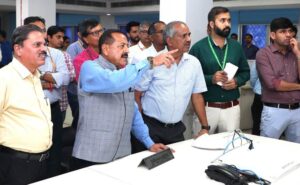 Union Minister Dr. Jitendra Singh today visited the India Meteorological Department (IMD) headquarters in New Delhi to review the department’s latest innovations, including the Web-GIS based Multi-Hazard Early Warning Decision Support System (DSS) and the citizen-centric “Mausamgram” platform.
Union Minister Dr. Jitendra Singh today visited the India Meteorological Department (IMD) headquarters in New Delhi to review the department’s latest innovations, including the Web-GIS based Multi-Hazard Early Warning Decision Support System (DSS) and the citizen-centric “Mausamgram” platform.
Dr. Singh lauded IMD’s strides in developing self-reliant, technology-driven weather forecasting tools, highlighting the DSS’s impact in saving ₹250 crore by ending dependence on foreign vendors and reducing maintenance costs. The system now serves as a critical component of India’s disaster risk reduction efforts, offering enhanced lead times and greater accuracy in forecasting.
During his visit, the Minister emphasized the growing role of artificial intelligence in next-generation weather systems and encouraged its integration into the “Mausamgram” platform to make hyperlocal forecasts even more intuitive and accessible for citizens.
“Mausamgram” delivers location-specific weather updates down to the gram panchayat level, accessible in all official Indian languages. It offers hourly, 3-hourly, and 6-hourly forecasts across various timelines, allowing users to stay informed via PIN code, place names, or administrative regions.
Dr. Singh also praised IMD’s achievements in e-Governance, recognizing its receipt of the National e-Governance Award 2025 for the DSS initiative. He noted the improvements in forecast generation — lead times increased from 5 to 7 days, preparation time cut by 3 hours, and accuracy enhanced by 15–20%.
The Minister commended the IMD’s commitment to Swachhata under the Special Swachhata Program 5.0. During his visit, he planted a sapling under the “Ek Ped Maa Ke Naam” initiative and felicitated 50 Safai Mitras for their contributions to cleanliness at “Mausam Bhavan”. The IMD’s efforts also led to the disposal of old files and e-waste, freeing up 600 square meters of space and generating ₹30 lakh in revenue.
Looking ahead, Dr. Singh outlined the goals of Mission Mausam, which aims to deliver dynamic, impact-based forecasts at a 5×5 km resolution by 2030. The mission will focus on last-mile connectivity to ensure early warnings reach every household, in line with the vision of “Har Har Mausam, Har Ghar Mausam.”




